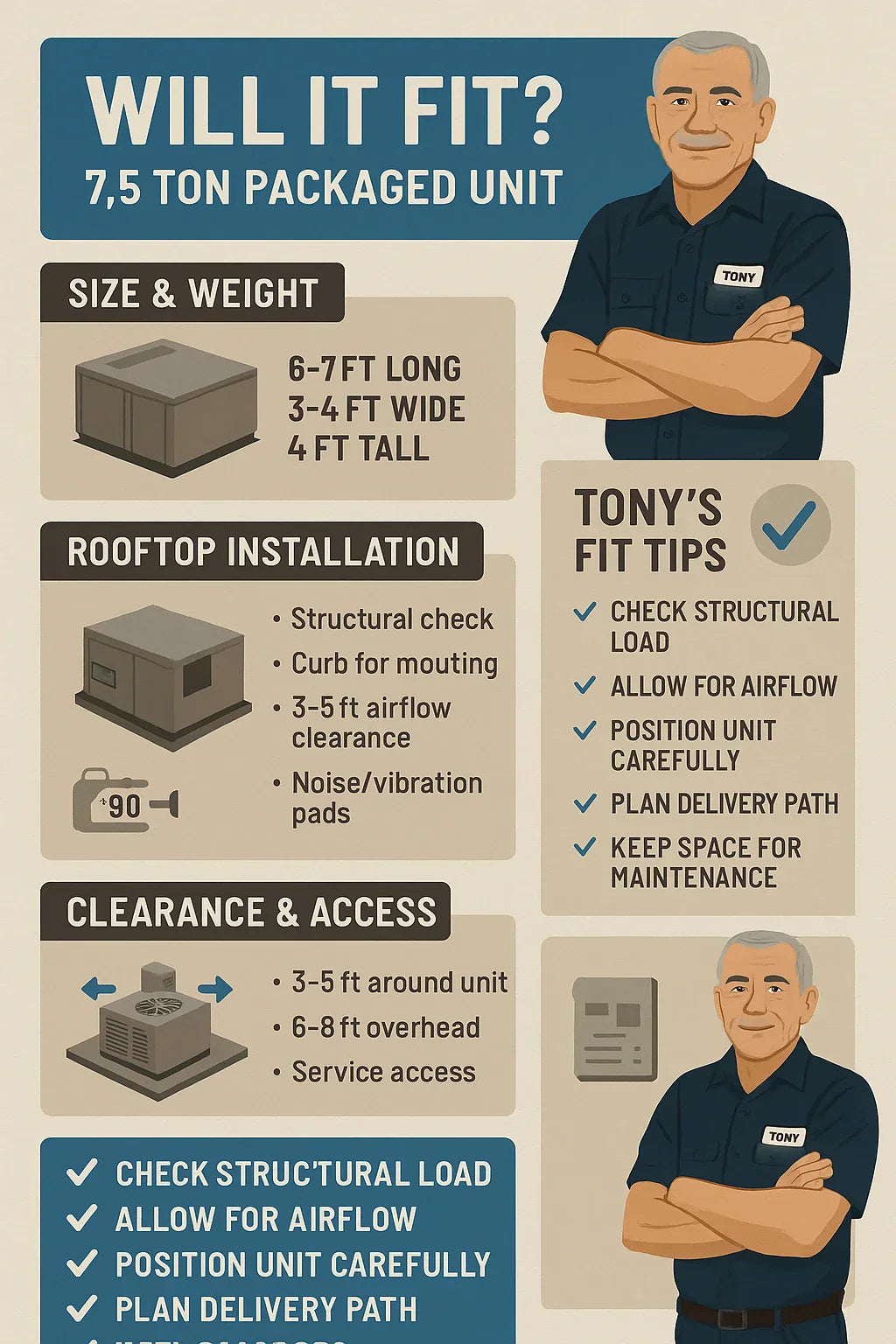A 7.5 ton packaged AC and gas furnace unit like the Daikin Light Commercial 7.5 Ton Packaged System (DFG0904DM00001S) isn’t a small piece of equipment. At close to 1,000 pounds and the size of a small car engine block, you can’t just “find a corner” for it.
Whether it’s going on your rooftop or a ground-level utility pad, you’ll need to plan ahead for weight, space, airflow, and service access. Let me walk you through the details so you don’t run into costly installation surprises.
📦 How Big Is a 7.5 Ton Packaged Unit?
Most commercial 7.5 ton packaged units fall into these ranges:
-
Length: 6–7 feet
-
Width: 3–4 feet
-
Height: 4 feet
-
Weight: 900–1,000 pounds
👉 That’s about the footprint of a large pallet or a compact pickup truck bed, but much heavier.
📌 Carrier’s commercial rooftop unit specs and Trane’s packaged unit data confirm these typical dimensions.
🏗️ Rooftop Installation Requirements
Rooftop installs are common for commercial packaged units — but they come with special considerations.
1. Structural Load
-
A roof must be able to handle at least 1,000 pounds in one spot.
-
Many buildings require an engineer’s approval before a crane sets the unit.
2. Mounting Curb
-
A roof curb (metal frame) is needed for proper installation.
-
Curb must match unit footprint (6x4 ft range) and be level.
3. Clearance for Airflow
-
3–5 ft clearance on all sides for airflow.
-
No obstructions above the discharge air section.
4. Noise & Vibration
-
Install vibration isolators or neoprene pads to reduce sound inside the building.
👉 Tony’s tip: Never set units back-to-back without space. Starved airflow = burned-out compressors.
📌 ASHRAE design standards require rooftop units to be spaced properly for airflow and service access.
🏢 Ground-Level Installation Requirements
Not every business has the roof strength or design for a packaged unit. Ground installs are the alternative.
1. Utility Pad Size
-
Pad should be at least 1 ft larger than unit footprint.
-
For a 6x4 ft unit, pad should be 7x5 ft minimum.
2. Pad Strength
-
Concrete thickness: 4–6 inches reinforced.
-
Designed to hold 1,000+ pounds without shifting or cracking.
3. Clearance from Structures
-
At least 3 ft from walls/fences for airflow.
-
At least 10 ft from windows (to avoid exhaust recirculation).
4. Drainage
-
Pad should be slightly raised to prevent water pooling.
👉 Tony’s tip: Don’t pour a cheap, thin pad. I’ve seen units sink into soft ground — not a fun fix.
📌 Energy.gov central AC installation guidance highlights pad leveling and drainage as key to ground installs.
📐 Clearance & Service Access
Beyond fitting the box, you need to leave room for technicians.
-
3–5 ft clearance on all sides for airflow.
-
6–8 ft overhead clearance for service or crane lifts.
-
Accessible panels: make sure techs can reach filters, coils, and furnace doors.
📌 ACCA Quality Installation Standards emphasize proper service clearances as critical for both performance and warranty.
👉 Tony’s tip: Don’t wedge it in a corner. If your tech can’t open the panel, your repair bill doubles.
⚠️ Common Fit Mistakes
I’ve seen more than a few jobs go sideways because someone didn’t think ahead.
-
Doorways and hatches: The unit can’t even get inside the building to the roof.
-
Undersized utility pad: Unit sinks or cracks the slab.
-
Too close to walls/other units: Starves airflow, reduces efficiency.
-
Blocked service access: Techs can’t reach components = costly fixes.
📌 HVAC cost guide notes that poor planning leads to unexpected install costs.
🏙️ Real-World Examples
Example 1: Rooftop Retail Store (5,000 sq. ft.)
-
Daikin 7.5 ton unit installed on engineered curb.
-
Structural reinforcement: $2,500.
-
Clearance: 5 ft around unit.
-
Result: Smooth airflow, easy service access.
Example 2: Ground-Level Restaurant (3,800 sq. ft.)
-
Installed on 8x5 ft concrete pad, raised 6 inches.
-
Drainage added to avoid water pooling.
-
Pad cost: $1,200.
-
Result: Stable and easy to service, quieter inside dining area.
Example 3: Medical Office Rooftop (4,200 sq. ft.)
-
Two 7.5 ton units placed too close together.
-
Efficiency dropped, compressors overheated.
-
Fix: $4,000 to relocate one unit for proper clearance.
👉 Tony’s lesson: It’s always cheaper to plan space right the first time.
✅ Tony’s Fit Checklist
Before you buy a 7.5 ton packaged unit, ask these questions:
-
🏗️ Can your roof handle 1,000 lbs in one spot?
-
📦 Is your pad at least 1 ft larger than the unit footprint?
-
🌬️ Do you have 3–5 ft clearance on all sides for airflow?
-
🔧 Can a technician easily reach service panels?
-
🚚 Do you have a clear delivery path (forklift, crane, or hatch)?
-
💧 Is the pad/site graded to avoid water pooling?
📊 Cost of Fit Adjustments
-
Roof reinforcement: $2,000–$5,000
-
Roof curb & installation: $500–$1,500
-
Concrete utility pad: $800–$1,500
-
Vibration pads/screens: $200–$800
👉 Tony’s tip: Budget 10–15% extra for site prep. It saves headaches down the road.
📌 Final Word from Tony
A 7.5 ton Daikin packaged unit will fit on most rooftops or pads if you plan ahead.
-
On the roof: Check structural load, use the right curb, and leave clearance.
-
On the ground: Build a strong pad, keep it clear of walls, and watch drainage.
Don’t let size intimidate you — but don’t wing it either. Measure twice, plan the install, and your unit will serve you for 15+ years without issue.
In the next topic we will know more about: Daikin vs. Carrier vs. Trane: Which 7.5 Ton Packaged System Should You Choose?







